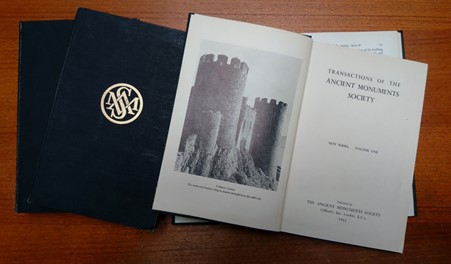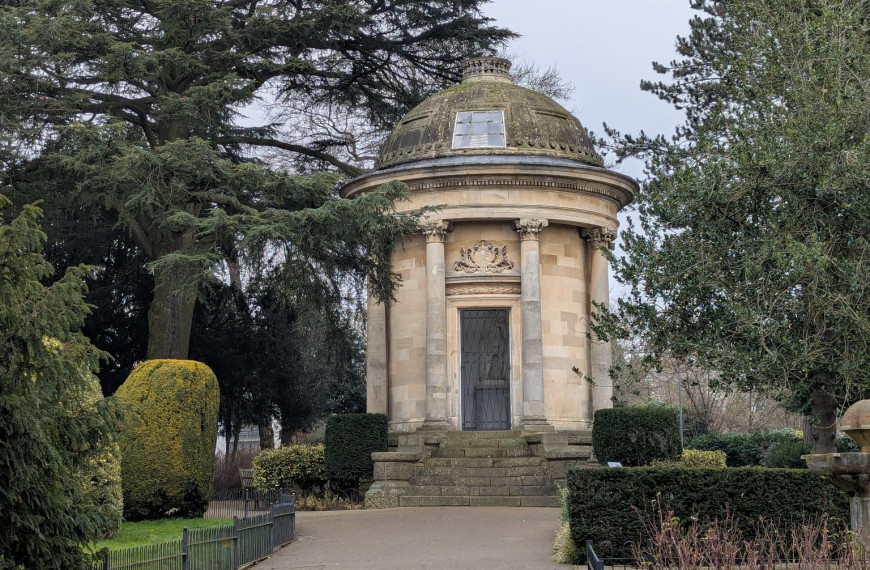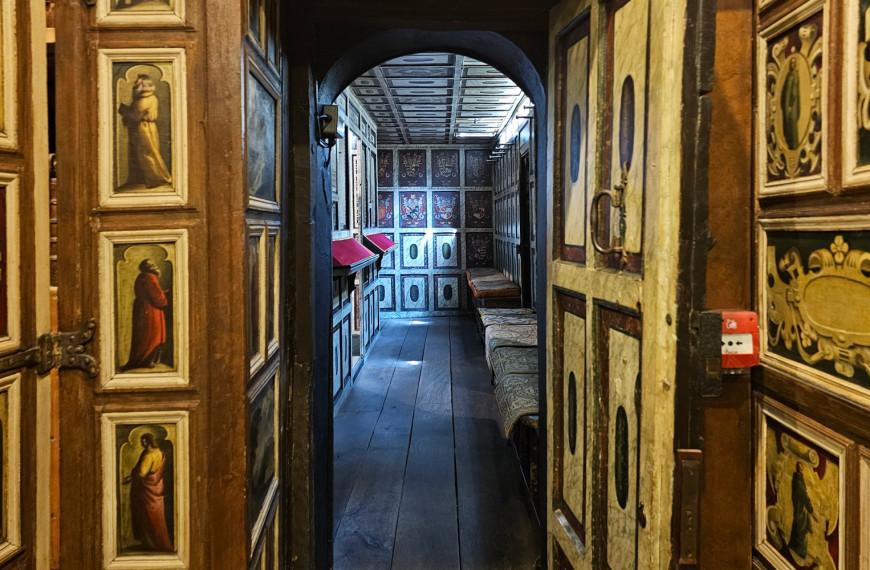In a new series of articles, we explore what the Transactions tell us about the history of the conservation movement.
The Ancient Monuments Society was an early defender of structures traditionally deemed ‘lesser’, and today continues to fight for buildings – be they cottages or factories – which are an essential part of Britain’s heritage.
The Ancient Monuments Society (AMS) was founded in 1924 by the architect and historian John Swarbrick. It was established to promote the conservation and study of historic buildings, structures and sites in England and Wales.
These aims were consolidated in the Transactions of the Ancient Monuments Society (TAMS), the first volume of which was published in 1953. The Transactions shared with the public articles on architectural history and conservation written by members of the AMS, as well as projects the society had been directly involved in. By doing so, the AMS hoped to ‘stimulate interest in Britain’s priceless heritage of monuments, buildings and craftsmanship.’[1]
From the outset, the Transactions makes clear that it will not be passive in its celebration of historic structures but that ‘the keynote of the [first] volume is action, for our object is not only the study of antiquities but also their conservation.’[2] ‘[W]e take up arms’, writes the AMS, ‘against [the] indiscriminate destruction’ of buildings, both great and small.[3]

The Transactions of the Ancient Monuments Society (1953)
Every year since 1953 a new volume of the Transactions has been published and sent out to members of the society. A complete set of the volumes is held in the British Library, the Royal Institute of British Architects (RIBA) Library and the Society of Antiquaries in London, and in the National Libraries of Scotland and Wales, with a few missing from the latter.
In this article, I will explore the first volume of the Transactions and consider what it tells us about the Ancient Monuments Society in the first few decades after it was founded.
Who was on the Council of the Ancient Monuments Society in 1953?
The first volume of the Transactions was compiled in 1953 by a council composed of some of the leading figures in building conservation in the mid-20th century, including architects, historians and writers.
The President of the AMS was the Earl of Rosse, Lawrence Michael Harvey Parsons, who was also an active member of the National Trust.
Raymond Richards, a county historian and antiquary who published Old Cheshire Churches in 1947, was the Chairman of the Council. The Vice-Chairman and Honourable Editor was another published historian, F. A. Bailey. He wrote an interesting article in the first volume, titled ‘An Old Watchmaker’s Shop’, which explores the history of watch- and clock-making in the town of Prescot in Merseyside (historically part of Lancashire).
The Director of the AMS in 1953 was Professor Albert Edward Richardson. Richardson was a leading architect and writer about architecture who was particularly interested in English buildings from the 18th century. Richardson was a Professor of Architecture at the University College London (UCL) and founder of the Georgian Group. He also served as the President of the Royal Academy of Arts and editor of the Architects’ Journal.
Richardson’s obituary in The Times celebrated his life which he devoted to conserving Georgian buildings across Britain. He was an eccentric character, uninspired by the ‘nylon, pylon and skylon’ of the modern age, as he put it.[4] In an effort to escape modern life, Richardson would host elaborate Georgian-themed dinner parties at his Bedfordshire home, Avenue House. He would don a wig, frock coat, knee-breeches and buckled shoes and serve his guests 18th-century style food.[5]
The Honorable Secretary of the AMS council in the early 1950s was Lionel Milner Angus-Butterworth. A historian, he wrote several books on a variety of topics, from Robert Burns and the 18th-Century Revival in Scottish Vernacular Poetry to The Manufacture of Glass.
There were other notable contributors to the volume, including John Swarbrick, the founder of the AMS, who I will discuss further in the second blog on casework.
What does the first volume of the Transactions tell us about the building conservation movement in the 1950s?
Volume one of the Transactions provides an important record of new developments in building conservation in the mid-20th century.
The building conservation movement grew in the 1940s and 1950s as Britain was freed from the strictures of the war effort, and the Transactions covers this evolution in detail.
It cites several important structures which had been recently demolished, such as Coleshill House, in Berkshire, built by Inigo Jones.[6]
But it also notes how new efforts were being made to protect country houses in England. One of the most significant contributions to this was the Report of the Gowers Committee on Houses of Outstanding Historic or Architectural Interest, which was published in 1950. It considered how the government might help owners of important country houses to finance the restoration and maintenance of their homes. The investigation was orchestrated by Stafford Cripps, the Chancellor of the Exchequer in Clement Attlee’s Labour government.
The Report of the Gowers Committee led to the creation of the Historic Buildings Council, which was set-up to provide annual grants for the preservation of outstanding buildings.[7]
The Transactions also records how the Historic Churches Preservation Trust (HCPT) was founded in 1952. The Chairman of the HCPT, Ivor Bulmer-Thomas, wrote a piece on the new organisation in the first volume of the Transactions. In it,he describes the ‘anxiety [felt] in informed circles about the condition of the fabrics of our parish churches’.[8] This ‘anxiety’ stemmed from the fact that ‘owing to the demands of the war and post-war conditions, only the most urgent and essential repairs could be undertaken.’[9]
The Historic Churches Preservation Trust was later replaced by the National Churches Trust, which continues to operate today. Ivor Bulmer-Thomas was an important figure in the world of church conservation who founded both the Redundant Churches Fund (which later became the Churches Conservation Trust) and the Friends of Friendless Churches, which today shares its office with the Ancient Monuments Society.
Country houses and churches were no longer a high priority for the Ancient Monuments Society, as they were well looked after by the new developments. In the Transactions, the AMS says its concern is for the many old buildings—domestic, industrial, commercial, public, and so on—found across Britain, which are more modest in character and therefore not so well protected. Put simply, ‘It is […] the lesser buildings which are causing the greatest anxiety.’[10]
The Transactions notes how some good work was being done to protect these ‘innumerable’ old buildings ‘which grace our towns and countryside’.[11] It refers, for instance, to the important Town and Country Planning Act of 1947 which (following on from an act of 1944) had started the process of ‘listing’ buildings of special architectural or historical interest.The Ministry of Local Government and Planning was compiling these lists to ensure that the buildings on them were safeguarded.
While the Transactions applauds these efforts, it also recognises that the listing process was ‘by no means watertight or even wholly satisfactory’.[12] In addition to these governmental efforts, the AMS believed that communities and organisations must be made aware of, and keep an eye on, historic buildings, both locally and nationally. That way, any plans to alter or demolish them could be flagged up and prevented. ‘There are’, the Transactions says, ‘limits to what any one such body can accomplish, and this is why we should all lend support to each other and work together in the closest alliance.’[13]
One organization, which is recorded in the Transactions as working alongside the AMS to protect these ‘lesser buildings’, was the Vernacular Architecture Group (VAG). The VAG was founded in 1952, just one year before the first volume of the Transactions was published.
It is significant that the first volume of the Transactions was published in the 1950s. As we have seen, new legislation was introduced and new societies founded in the post-war years, leading to major new advances in building conservation in Britain.
The AMS—and its body of intellectuals, directed by Professor Albert Richardson—used the Transactions to situate itself at the forefront of post-war efforts to protect historic buildings, structures and sites in England and Wales. The Transactions shows how the AMS was one of the first to acknowledge that structures traditionally deemed ‘lesser’—in scale or value, due to their status as utilitarian rather than religious or polite—were in fact both historically and architecturally significant and therefore worthy of preservation. Today, the Ancient Monuments Society continues to fight for these buildings—be they cottages or factory buildings, which are an essential part of Britain’s heritage.
Coco Whittaker
Coco Whittaker is a recent graduate of the University of Cambridge, where she studied History of Art and Architecture. She specialised in architectural history and wrote her dissertation on 16th and 17th century church pews in Shropshire. Coco will be returning to Cambridge in October to study on the part-time MSt in Building History. She has a keen interest in historic buildings and structures and their conservation.
Bibliography
Transactions of the Ancient Monuments Society, Vol. 1, (Clifford’s Inn, London: The Ancient Monuments Society, 1953)
Sir Albert Edward Richardson’s obituary in The Times, (February 4, 1964), https://www.nytimes.com/1964/02/04/archives/sir-albert-richardson-is-dead-championed-the-georgian-era-head-of.html
‘Timeline of Conservation Catalysts and Legislation: A history of listing since 1560’ on Historic England website, https://historicengland.org.uk/whats-new/features/conservation-listing-timeline/
[1] Transactions of the Ancient Monuments Society, Vol. 1, (Clifford’s Inn, London: The Ancient Monuments Society, 1953) p.7.
[2] Ibid.
[3] Ibid.
[4] Sir Albert Edward Richardson’s obituary in The Times, (February 4, 1964), p.33. https://www.nytimes.com/1964/02/04/archives/sir-albert-richardson-is-dead-championed-the-georgian-era-head-of.html.
[5] Ibid.
[6] Coleshill House was demolished in 1958 after a fire damaged much of the interior. Transactions, p.8.
[7] The Historic Buildings Council in England was replaced in the 1980s by the Historic Buildings and Monuments Commission, better-known as English Heritage (now Historic England).
[8] Transactions, p.49.
[9] Ibid.
[10] Transactions, p.8.
[11] Ibid.
[12] Ibid.
[13] Ibid.


